By Erika Segerson-Mueller, DNR Invasive Plant Program Specialist, Oshkosh Service Center;
Erika.SegersonMueller@wisconsin.gov or 715-492-0391
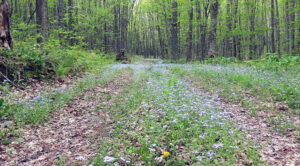
A forest road is covered by a blanket of Woodland forget-me-not. / Photo Credit: Caleb Slemmons, National Ecological Observatory Network, Bugwood.org
These easy-to-grow, sweet-sounding, small blue flowers may seem appealing, but you should forget about forget-me-nots. A garden plant frequently found in mixed bouquets, forget-me-nots can easily escape the confines of a garden and spread aggressively.
There are two species regulated as invasives in Wisconsin: an Aquatic forget-me-not (Myosotis scorpiodes) and Woodland forget-me-not (Myosotis sylvatica). Both species are restricted under Wisconsin’s Invasive Species Rule NR40, so control is encouraged if they are found on your property. These species cannot be transferred, transported or introduced without a permit.
Both the aquatic and woodland species of forget-me-not bloom in early spring and can share many visual characteristics.
Aquatic forget-me-not (Myosotis scorpiodes):
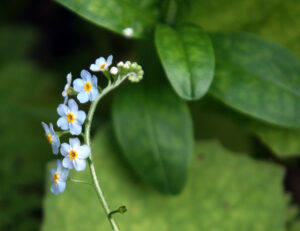
The curved spiral of flower buds on Aquatic forget-me-not (Myosotis scorpiodes) can resemble a scorpion’s tail. / Photo Credit: Wendy VanDyk Evans, Bugwood.org

Aquatic forget-me-not spreads quickly and creates large monocultures on streambanks. / Photo Credit: Leslie J. Mehrhoff, University of Connecticut, Bugwood.org
Aquatic forget-me-not is commonly known as “true forget-me-not” and sometimes called “scorpion grass” due to the spiraling curve of its flower buds, which can resemble a coiled scorpion’s tail. Its scientific name, Myosotis scorpiodes, also references this resemblance – Myosotis means mouse ear, a reference to the size and shape of the plant’s petals, and the species name (scorpiodes) means scorpion-like.
Aquatic forget-me-not quickly crowds out native plant species and forms large monocultures (an area in which one plant type completely dominates the landscape, displacing all other species), especially near streams. It is an easy spreader that is difficult to control, producing abundant seeds and reproducing through stolons (horizontal stems that creep along the ground and root at the nodes or tips to give rise to new plants). It can also take habitat away from threatened or endangered Wisconsin native plants.
To control aquatic forget-me-not, mechanical removal is best. Smaller populations can be pulled or dug, with all pieces of the root system removed to avoid resprouting. Little is known of the effectiveness of chemical treatment, and if in aquatic areas, a permit may be required to use herbicides.
Woodland forget-me-not (Myosotis sylvatica):
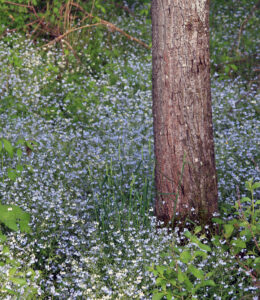
Woodland forget-me-not may resemble a fluorescent blue carpet when it creates large forest infestations. / Photo Credit: Steven Katovich, Bugwood.org
Woodland forget-me-not is also commonly called “garden forget-me-not,” though its species name, sylvatica, means “of the woods.” It easily escapes gardens and forms dense infestations in forests, appearing as if it were a florescent blue carpet.
Woodland forget-me-not may resemble a florescent blue carpet when it creates large forest infestations. / Image Credit: Steven Katovich, Bugwood.org
Woodland forget-me-not also forms large monocultures, crowding out native plant species and reducing the number of spring ephemeral wildflowers. It is challenging to control as it produces great numbers of seeds and reproduces by spreading stolons, in a manner similar to aquatic forget-me-not.
Mechanical removal is also best to control woodland forget-me-not. Smaller populations can be hand-pulled or dug out before seeding, with care taken to remove the entire root system. Monitor for resprouting after removal.
Though little information on the effectiveness of chemical treatment exists, foliar spray treatments in spring or summer may be successful. As with most invasive plants, repeated treatments and monitoring will be required for several seasons.
Identifying Forget-me-nots
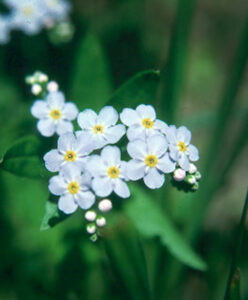
Woodland forget-me not is visually similar to Aquatic forget-me-not. / Photo Credit: Wisconsin DNR
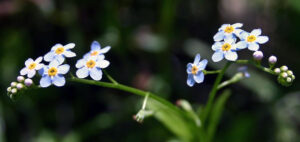
Aquatic forget-me-not is visually similar to Woodland forget me not, making the plants difficult to tell apart. / Photo Credit: Leslie J. Mehrhoff, University of Connecticut, Bugwood.org
All species of forget-me-not found in Wisconsin have very similar appearances. Each has small flowers with five petals; petal coloring is often blue with a yellow center, though in rare occasions it can be white. Species bloom between May and September. To differentiate between one of the invasive forget-me-not species and the native forget-me-not that is rather rare in Wisconsin, it is necessary to look very closely at the plant.
At the base of each flower is a cup-like structure called the calyx. The calyx contains the sepals (segments) that enclose the petals and form a protective layer around the flower when in bud. Each sepal of a woodland forget-me-not will have spreading, hooked hairs present.
Because correct identification is quite difficult, it is best to be sure which species is present before controlling the plant. To avoid having to get out your magnifying glass, don’t buy or plant forget-me-nots unless you are certain they are the native species. Many seed packets are labeled only as “forget-me-not,” so it can be difficult to know exactly which species you are buying.
There are several native plants that serve as good alternatives to forget-me-not.
Jacob’s ladder (Polemonium reptans) is a woodland perennial with small, lavender-blue flowers that bloom in April or May and serve as a food source for early pollinators. It grows well in moderately shady sites with loose, rich soil.
For similar, blue-shaded blooms, look at dwarf crested iris (Iris cristata), wild blue phlox (Phlox divaricata) or Virginia bluebells (Mertensia virginica). Each is a native wildflower that makes a great addition to a spring woodland garden without the possibility of escaping and creating a monoculture in your woods.
